Archive Record
Images
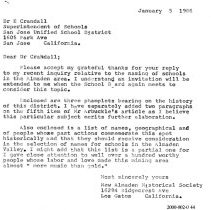
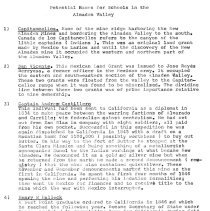

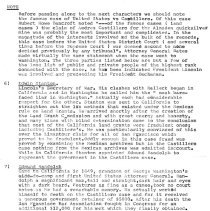
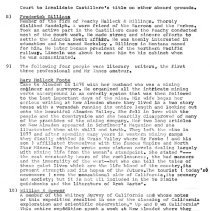
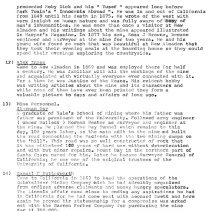
Additional Images [5]
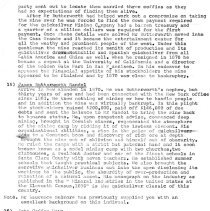
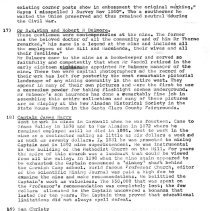
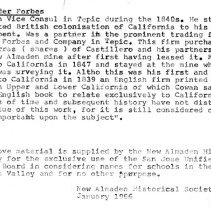
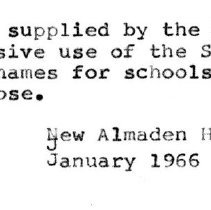
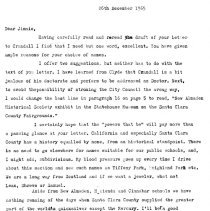
Metadata
Catalog number |
2000.1.41 |
Object Name |
Letter |
Date |
1966 |
Description |
January 5 1966 Dr E Crandall Superintendent of Schools San Jose Unified School District 1605 Park Ave San Jose, California. Dear Dr Crandall; Please accept my grateful thanks for your reply to my recent inquiry relative to the naming of schools in the Almaden area. I understand an invitation will be extended to me when the School Board again meets to consider this topic. Enclosed are three pamphlets bearing on the history of this district. I have separately added two paragraphs on the fifth item of Mr Arbuckle's article as I believe this particular subject merits further elaboration. Also enclosed is a list of names, geographical and of people whose past actions commemorate this spot historically and that they should receive consideration in the selection of names for schools in the Almaden Valley. I might add that this list is a partial one for I gave close attention to well over a hundred worthy people whose labor and love made this mining area almost " more music than gold." Most sincerely yours New Almaden Historical Society 16294 Ridgecrest Ave Los Gatos, California. 2000-002-0 44 Potential Names for Schools in the Almaden Valley 1) Capitancellos. Name of the mine ridge harboring the New Almaden Mines and bordering the Almaden Valley to the south. Canada de los Capitancellos refers to the canyon of the little captains (Indians). This was an original land grant made by Mexico to Larios and until the discovery of the New Almaden mine it occupied the western and northern part of the Almaden Valley. 2) San Vicente. This Mexican Land Grant was issued to Jose Reyes Berryessa, a former officer in the Mexican army. It occupied the eastern and southeastern section of the Almaden galley. These two grants were floated from the valley to the Capitancellos range when it was found to be mineralized. The dividing line between these two grants was of prime importance relative to mine ownership. 3) Captain Andreas Castillero This individual had been sent to California as a diplomat in 1834 to make peace between the warring factions of Alvarado and Carrillo; viz federalism against centralism. He had set out from San Blas in company with eight soldiers, all paid from his own pocket. Successful in this expedition he was again dispatched to California in 1845 with a draft on a Mazatlan bank for $100,000 ( possibly worthless ) to buy out Sutter. On his way to the fort of Sutter he stopped at the Santa Clara Mission and being something of a metallurgist accompanied Sunol to the Indian workings at what became New Almaden. He denounced it as a gold aid silver mine but when he returned from the north he made a second denouncement ( registry ) that the mine also contained quicksilver. These November and December denouncements marked this mine as the first in California. He spent the first four months of 1846 opening the mine and perfecting his location formalities; then want to Mexico for finances and to receive title to the mine which the war with Mexico interrupted. 4) Henry W Halleck A West Point graduate ordered to California in 1846 and which he reached the following year. Became Secretary of State under Mason, assisted in formulating laws for California during Gold Rush and later of the State's Constitution, Made a thoro (sic) study of land grants in California and was extremely responsible for formation of United States Land Grant Commission. He collected some four thousand documents on this subject which he turned over to Edwin Stanton when he came to California and which were of great value to him but who gave Halleck no thanks. In 1851 he was instrumental in the formation of the famous San Francisco law firm of Peachy Halleck & Billings. This firm handled some 800 land grant cases in California of which the most important was that of United States vs Castillero for ownership of the New Almaden mine. Halleck wrote most of the firm's briefs tho (sic) he was not admitted to the California bar until 1853. In 1853 he planned and built the reknowned Montgomery Block building in San Francisco. ( See I Jones book "Ark of Empire") In 1850 he was appointed manager of the New Almaden mine by his intimate friends Barron and Forbes in Tepic Mexico. His engineering abilities quickly brought order out of the chaos that had formerly attended the mine's development and the Barron Forbes firm which owned the mine, confident of Halleck's reports made a million dollars available to him for its exploration. Halleck proceeded to make it the most celebrated quicksilver mine on earth and for many years it outshone the ancient Almaden mine, its namesake, in Spain. Weekly, Halleck was driven along the Almaden road, pass (sic) the Irene Henderson and Bret Harte schools from his San Francisco offices to those in the Casa Grande at the New Almaden Hacienda. He had caused this lovely mansion to be built in 1853. Originally it was planned for a one story hotel (a two story adobe hotel, the first built in California, already existed in the Hacienda) but both Halleck and superintendent John Young so fell in love with it that a second floor was added and it became a residence for both of them. For many years it was one of the showplaces of California and endless celebrities were entertained here. Each Saturday at noon Halleck was again driven back to San Jose along the Almaden road (in his wagon). In August of 1861 Major General Scott had Lincoln appoint Halleck Major General in the army (from which he had retired in 1854). His first assignment was putting order into the terrible fiasco Fremont had made in army headquarters and the fortifications at St Louis after which Lincoln called him to Washington. Here he became General-in Chief of the Union armies until Grant was given this post whereupon Halleck was made Chief-of--Staff. He was the first and last officer in this post for 39 years. Tho disliked in Washington by almost everyone from Secretary of War Stanton to Attorney General Bates and tho no fighting man he was Lincoln's confident (sic) all thru the Civil War and highly respected by him In retrospection regarding the Lincoln-Swett affair when Billings wired Halleck on the subject, since it was a military order and as it had not passed his desk, he wired General Wright that it had been "surreptiously obtained" and that if the mine had been sized (sic) it was to be repaired and returned to Barron Forbes. This incident hardly improved Lincoln's position in the matter. General George Wright. His discreet judgment in over-riding Marshall Rand in taking possession of the mine without doubt averted bloodshed and turmoil in California. NOTE Before passing along to the next characters we should note the famous case of United States vs Castillero. Of this case Hubert Howe Bancroft noted "---of the famous cases (land cases) the claim of Andres Castillero for the Almaden quicksilver mine was probably the most important and complicated. In the magnitude of the interests involved and the bulk of the records, this case before the United States District Court (and several times before the Supreme Court) was deemed second to none decided previously by any tribunal". Attorney General Bates made virtually the same statement when the case went to Washington. The three parties listed below arc but a few of the long list of public and private people of the highest rank connected with the case. As has been indicated President Lincoln was involved and preceeding him President Buchanan. 6) Edwin Stanton Lincoln's Secretary of War. His clashes with Halleck began in California and in Washington he called him the " most bare-faced liar in Washington." Actually each had considerable respect for the other. Stanton was sent to California to straighten out the lax methods that existed under the Mexican rule on Land Grants. He arrived shortly after the creation of the Land Grant Commission and with great energy and honesty, and many times with blind determination came to the conclusion that most of the California land grants were fraudulent ones; including Castillero's. He was particularly convinced of this over the Limantour claim for all of San Francisco which proved to be fraudulent. Oddly enough in this case fraud was proved by examining the Mexican archives but in the Castillero case nothing from the Mexican archives was admitted in court. While in California Stanton appointed Edmund Randolph to represent the government in the Castillero case. 7) Edmund Randolph Came to California in 1849, grandson of George Washington's aide-de-camp and first United States Attorney General. Randolph, a magnificent man, tall and straight, dark hair and eyes with a dark beard. Features as fine as a cameo, took no court notes as he had a remarkable memory. He actually worked himself to death on the Castillero case and for it received a generous government retainer of $5,000. After his death the San Francisco Bar Association fought in Congress for an additional $12,000 for his work which they finally obtained. Randolph did all the work for this sum and Stanton who did virtually nothing was paid $25,000. All thru the Castillero trial he insisted that all of Castillero's documents were fraudulent and forgeries and even these dishonestly placed in the archives. As the government would accept neither testimony nor documents in Mexico the defendants brought a privately chartered boatload of prominent witnesses from Mexico and Randolph doubted their identity. Randolph lost his case before the District Court but the taint of forgery caused the Supreme Court to invalidate Castillero's title on other absurd grounds. 8) Frederick Billings Member of the firm of Peachy Halleck & Billings, Thoroly (sic) disliked Randolph. A warm friend of the Barrons and the Forbes. Took an active part in the Castillero case tho Peachy conducted most of the court work. He made strong and sincere efforts to settle the Lincoln-Swett affair. He was keenly interested in education and he named Berkeley. Billings in Montana named for him. He later became president of the Northern Pacific railway. Lincoln was about to name him to his cabinet when he was assassinated. 9) The following four people were literary writers, the first three professional and Mr Innes amateur. Mary Hallock Foote Came to Almaden in 1876 with her husband who was a mining engineer and surveyor. He organized all the intricate mining works underground in an orderly system that was then followed to the last important days of the mine. His wife began her serious writing at New Almaden where they lived in a two story house with a verandah running its entire length and looking out onto the beautiful Almaden Valley. She fell in love with the people and the countryside and she heartily disapproved of many of the practices of the mining company. Her two long articles on New Almaden appeared in Schribner's Magazine and she illustrated then with skill and truth. They left the mine in 1877 and after spending many years in western mining camps they finally settled in Grass Valley where Mr Foote (and his son ) affiliated themselves with the famous Empire and North Star Mines. Mrs Foote wrote some sixteen novels dealing largely with mining life from the woman's standpoint. She stated "-- the east constantly hears of the recklessness, the bad manners and the immorality of the west -- but who can tell the tales of those quiet lives which are the life blood of the country, its present strength and its hopes of the future. The tourist (today's newcomers) sees the sensational side of California, its scenery and society; but it is not all included in the Yo Simite (sic)[Yosemite] guidebooks and the literature of Bret Harte". 10) William H Brewer A member of the Whitney Survey of California and whose notes of this expedition resulted in one of the classics of California exploration and scientific observation," Up and Down California" This entire expedition spent a week at New Almaden where they explored the countryside and wrote of the mine and its population and hospitably (sic) hosts. 11) J. Ross Browne The premier early day writer of California and them west. Most of writings he illustrated which gave his Mark Twain style of humor a double edge, His " Adventures on a Whaling Cruise" preceded Moby Dick and his "Yusef" appeared long before Mark Twain's "Innocents Abroad ". He was in and out of California from 1849 until his death in 1875. He wrote of the west with warm insight on human nature and was fully aware of many of man's inhumanities. He was more than once a visitor at New Almaden and his writings about the mine appeared illustrated in Harper's Magazine. In 1877 his son, Ross J Browne, became engineer and surveyor at the mine for two years. He and his young wife found so much that was beautiful at New Almaden that they took their evening meals at the boarding house so they could spend their evenings exploring the countryside. 12) Alex Innes Came to New Almaden in 1869 and was employed there for half a century. He was familiar with all the workings of the mine and acquainted with virtually everyone ever connected with it. For a time he was Justice of the Peace. His evident hobby was writing articles about the mine and its characters and while none of them have ever been printed they form a valuable picture to days and affairs of long ago. 13) Mine Personnel. Sherman Day A graduate of Yale's School of mining where his father was father was president of the University. Followed army engineer (under Halleck) Norman Bestor as surveyor and engineer at the mine. He planned the Day Tunnel which remains to this day, 108 years later, as the main adit to the mine and built the road connecting the Hacienda with the two mining camps on the 'hill'. This road was so well constructed of rock that it has withstood 100 years of hard use without deterioration and with but minor repairs. Mount Day in the northern part of Santa Clara named for him. Later he became Surveyor General of California; he was one of the original trustees of the University of California. 14) Samuel F Butterworth Came to California in 1863 to head the operations of the Quicksilver Mining Company which he had adroitly organized from endless adverse claimants and money hungry speculators. The Lincoln affair came close to ending any aspirations he had in California for he had come west with Leonard Swett and here again he proved his statemenship (sic) for a compromise was worked out with the Barron Forbes Company for purchasing the mine for $1,750,000. Mr Butterworth's first trip to California a year or so previously had almost ended disasterously (sic) too for he and his two companions became lost in Apache country and the rescue party sent out to locate them carried three coffins as they had no expectations of finding them alive. After Mr Butterworth had helped work out a compromise on taking the mine over he was forced to find the down payment required for the Quicksilver Mining Company had a barren treasury and a quarter of a million dollars was required for the first payment. Once these details were solved Mr Butterworth moved into the Casa Grande and it became the entertainment center for all the wealthy and prominent people of the west. Under this gentleman the mine reached its zenith of production and its quicksilver drove Rothchild and Spanish quicksilver from all Latin America and China as well. When he resigned in 1870 he became a regent at the University of California and a director of the Golden Gate Park in San Francisco. In his endeavor to appease the financial appetite of his stockholders the mine appeared to be finished and by 1870 was close to bankruptcy. 15) James Butterworth Randol Arrive in New Almaden in 1870. He was Butterworth's nephew, but thirty years of age and had been connected with the New York office since 1863. He knew nothing of mining or how to handle people and in addition the mine was virtually bankrupt. In this plight the stockholders raised $200,000, paid off $146,000 of due debts and sent the balance to Randol to bring the mine back to bonanza status. He, upon competent advice, commenced deep mining, brought in Cornish miners, regenerated the atmosphere of the mining camp by ridding it of the lawless element. His organizational abilities, a rise in the price of quicksilver due to a Comstock boom and discovery of rich ore at depth brought the mine out of oblivion and himself out of obscurity. He ruled the camps with a strict but paternal hand and it soon became known as a model mining camp with two churches, two clubhouses, a resident doctor and one of the finest schools in Santa Clara County with seven teachers. He established summer schools that taught practical subjects. He also brought the secretive quicksilver business out into the open disclosing its workings to the public, the absurdity of over-production and ruination of a natural asset. His monograph on the industry as published in the " Mineral Industries in the United States at the Eleventh Census, 1890" is the quicksilver classic of this country. Note, Mr Laurence Bulmore has previously supplied you with an excellent background on this individual, 16) John Coffee Bays - Colonel Jack Hays) Rose to the rank of Mayor with the Texas Rangers after fighting to free Texas from Mexico. As a colonel fought with both Taylor and Scott in Mexico. In 1850 came to San Francisco and his reputation promptly made him sheriff of San Francisco twice. Owned the Peralta Ranch in Oakland. A personal friend of both President Polk and Pierce, the latter appointed him Federal Surveyor of California which was a very important post with the processing of land grants. By 1856 his office had surveyed over eight million acres of land. In 1860 he surveyed the San Vicente and Capitancellos grants and some of the presently existing corner posts show in embossment the original marking," Hayes (misspelled) Survey Nov 1860". Tho a southerner he wanted the Union preserved and thus remained neutral during the Civil War. 17) Dr S. E. Winn and Robert R Bulmore. These gentlemen were contemporaries at the mine. The former was the beloved doctor of all the community and of him Dr Thorne remarked, "his name is a legend at the mine and includes all the employees of the Hill and Hacienda, their wives and all their families." Mr Bulmore came to the mine as a bookkeeper and served so faithfully and competently that when Mr Randol retired in the early eighteen eighties [nineties] appointed Mr Bulmore manager of the mine. These two were capital photographers and the record of their work has left for posterity the most remarkable pictorial landscape of any mining community in the entire west. They appear in many of their own pictures and were the first to use a magnesium powder for taking flashlight scenes underground. Mr Bulmore's son Laurence has done a remarkably fine job in assembling this entire collection and many of there pictures are on display at the New Almaden Historical Society in the State House Museum in the Santa Clara County Fairgrounds. 18) Captain James Harry Went to work in mines in Cornwall when he was fourteen. Came to Grass Valley in 1870 and to New Almaden in 1872 where he remained employed until he died in 1895. Went to work in the mine as a contractor making as little as six dollars a week and as much as seventy dollars. In 1881 he was promoted to mining Captain and in 1892 mine superintendent. He was instrumental in the building of the Methodist Church on the Hill. For years the spire of this church was a landmark that could be viewed from all the valley. In 1890 when the mine again appeared to be exhausted, the Captain commenced a 'dinkey' shaft behind the Cornish Camp school. World famous Professor Church, editor of the Scientific Mining Journal was paid a high fee to examine the mine and make recommendations. He belittled the Captain's work as valueless. The $50,000 that was spent on the Professor's recommendation was completely lost; the few dollars allocated to the Captain uncovered a bonanza that lasted for ten years. The Captain thus proved that educational limitations did not always spell defeat. 19) Sam Christy This red bearded energetic brilliant and warm professor of Mining at the University of California had graduated there with the first class in mining. He made endless trips to the mine during the regime of Mr Randol wherein he became an expert on not only the mine but the quicksilver industry as well. He translated everything on the subject from the French German and Spanish and wrote endless reports on this subject. He brought his students to the mine during summer vacations where they gained first hand mining experience under his guidance. One of his top students became surveyor in 1887 and in 1903 he brought Ed Willowby back to California where he taught practical mining. 20) Alexander Forbes British Vice Consul in Tepic during the 1840s. He strongly advocated British colonization of California to his government. Was a partner in the prominent trading firm of Barron Forbes and Company in Tepic. This firm purchased the barras (shares) of Castillero and his partners in the New Almaden Mine after first having leased it. Forbes came to California in 1847 and stayed at the mine while Lyman was surveying it. Although this was his first and only visit to California in 1839 an English firm printed his book on Upper and Lower California of which Cowan says," the first English book to relate exclusively to California. The changes of time and subsequent history have not disturbed the value of this work, for it is still considered one of the most important upon the subject". Note The above material is supplied by the New Almaden Historical Society for the exclusive use of the San Jose Unified school Board in considering names for schools in the Almaden Valley and for no other purpose. New Almaden Historical Society January 1966 |
People |
Billings, Frederick Butterworth, Samuel Fowler Castillero, Andres Day, Sherman Halleck, Henry (Wager, Sr., Jr.) Hays, John (Coffee) Innes, Alex (A.C.) Randol, James Butterworth Stanton, Edwin Wright, George |
Cataloged by |
Boudreault, Art |
Collection |
Anonymous/Unknown 1 |
